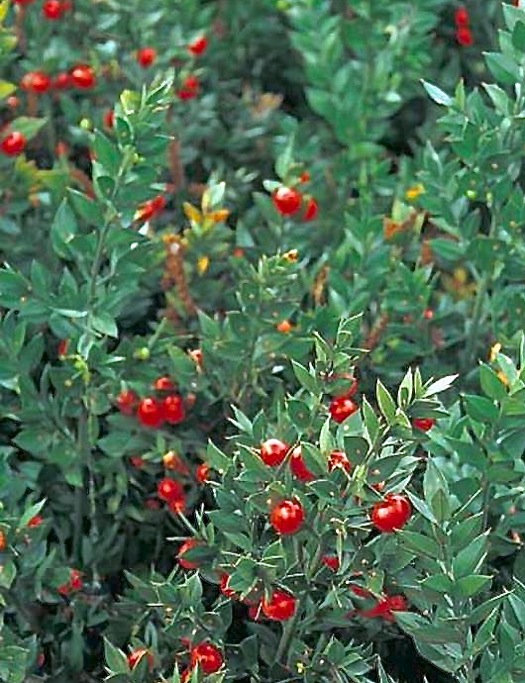Butcher's Broom in the Garden
 Saturday, January 10, 2015 at 5:00PM
Saturday, January 10, 2015 at 5:00PM I recently acquired Ruscus aculeatus, commonly called Butcher's Broom, for my woodland garden. A spot near a tree needed an evergreen to provide some winter interest. Historically, butchers used this plant to make brooms for their shops, thus the name. Butcher's Broom grows to about two to three feet, with small stiff leaves terminating with single, sharp spines. Because of its height, another common name is Knee Holly.
When I first saw the plant at the nursery, I eyed the prickly leaves with doubt. One needs thick gloves to handle this plant! However, the dark green, lustrous leaves are quite beautiful, reminiscent of holly leaves, although Butcher's Broom is in the lily family, not holly. What won me over are the berries: bright red and marble-sized!
A native to southern England, Butcher's broom grows in US hardiness zones 7 - 9. It loves moist, well-drained situations, but it adapts to most soils and is drought-tolerant. It is an excellent choice for woodlands, enjoying partial to full shade. Small greenish-white flowers are produced in spring. Traditionally, one needed both male and female plants for berry production, but there are now hermaphrodite forms available that have both stamens and pistils (the male and female parts) on the same plant. This is the type I was fortunate to find for my own garden. The flowers are followed by large berries that ripen to scarlet red in September, then provide a cheerful decorative note to the garden all the way into January.
Butcher's Broom will happily survive neglect. Old leaves will turn to brown skeletons after several years, and one may want to remove them, but otherwise little care is needed. New leaves will have grown to take the place of old ones. The plant will slowly spread by rhizomes and may eventually form a small colony.
I put my Butcher's Broom close to a path in the woodlands so I can enjoy it on my walks, but left plenty of room for it to expand without endangering visitors with its sharp leaf-tips. I think an evergreen fern would make a great companion, so I plan to place a native holly fern nearby. I am fortunate that here in Alabama the ground does not freeze in winter, so on a pretty day I can get out and plant in the garden!
